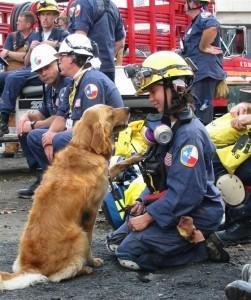
Denise Corliss is pictured with her search dog Bretagne at Ground Zero in New York City in September 2001. It was their first deployment together.
Some heroes boast muscle and brawn. Others possess steely nerves and impeccable timing. But this hero is a little different.
This one has feathery fur, a sunny smile, a calm nature and — for a dog — an uncanny ability to zero in on the people who need her most. She’s a 15-year-old golden retriever named Bretagne, and she’s one of the last surviving search dogs who worked at Ground Zero in New York City after the Sept. 11, 2001 terrorist attacks. (Another surviving 9/11 search dog named Woodie, a 15-year-old golden retriever, also worked at Ground Zero, and a 15-year-old English springer spaniel named Morgan worked at Staten Island.)
For the first time since the recovery efforts after the attack, Bretagne returned this week to the site of the former World Trade Center complex with her longtime handler and owner, Denise Corliss of Cypress, Texas.
Corliss fought back tears as she gazed at the 9/11 Memorial’s enormous waterfalls and reflecting pools, which are surrounded by bronze panels bearing the names of the nearly 3,000 people killed in the attacks.
“Seeing this kind of took my breath away a bit, similar to how the pile was the first time I saw it,” Corliss, 49, told TODAY.com. “It’s so calm and peaceful now, unlike the chaos of before.
“After 9/11, everybody — all of us — felt such sadness. We all wanted to help. I just felt so honored that we were able to respond.”
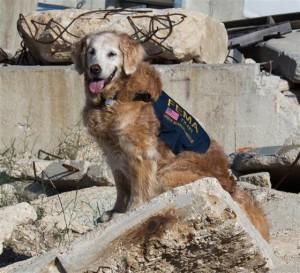
Bretagne still loves solving search problems at a disaster training site for dogs in Texas. This photo was taken in July 2014.
This year, Bretagne (pronounced “Brittany”) is one of eight finalists for the American Humane Association’s annual Hero Dog Awards. Corliss is preparing to travel with Bretagne to Beverly Hills for a stroll down the red carpet on the night of the award ceremony in late September — a prospect that seems surreal to Corliss, considering how her journey with the dog began.
In the late ‘90s, Corliss, an electrical engineer, became fascinated by the work of disaster search dogs. She learned that civilians — volunteers who receive no pay at all and work and travel at their own expense — can undergo rigorous training with their dogs. If they make the cut, a dog/handler team can support federal emergency response efforts at disaster sites around the United States.
In the fall of 1999, Corliss brought home Bretagne, a wriggly 8-week-old puppy who had much to learn and wanted to learn it.
“I was so excited about doing this, but I didn’t have the appreciation of how life-changing it would be,” Corliss recalled. “It took 20 to 30 hours a week easily to stay on top of training. This is what I did when I wasn’t at work.”
In 2000, Corliss received news that thrilled her: She and Bretagne qualified as official members of Texas Task Force 1. This meant the pair had what it takes to scour a disaster site and find survivors buried in the rubble.
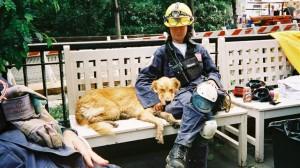
Denise Corliss and Bretagne take a break together at Ground Zero in 2001.
What they never could have anticipated was the site of their first deployment: The twisted pile of steel beams, concrete and ash where the World Trade Center once stood.
It was a harrowing assignment for the most seasoned rescue workers, and it could be a frustrating one for search dogs because there were no human survivors to be found — only human remains.
“I really believed we could find somebody — anybody! — if we could just get to the right void space,” Corliss said. “But our reality was much different. We found all various kinds of remains, some recognizable, others not so much.”
Bretagne persevered through nearly two weeks of 12-hour shifts at Ground Zero. On her very first search, she had to balance precariously on a wet metal beam — and she slipped. But she recovered quickly, pulling herself back up onto the beam with her front paws and continuing to sniff intently as if nothing had happened.
Even though she had just turned 2 — an age when many canines relish romping, chewing and making mischief — Bretagne kept offering herself up to grim-faced first responders. On one occasion, Bretagne left Corliss’ side with urgency and hurried toward a sullen firefighter sitting on the ground. Concerned, Corliss implored Bretagne to come back, sit and stay — to no avail.
“I was surprised that she wasn’t listening to me, but she really wasn’t — it was like she was flipping me the paw,” Corliss said. “She went right to that firefighter and laid down next to him and put her head on his lap.”
Dr. Cindy Otto, a veterinarian who cared for 9/11 search dogs at Ground Zero, said the 300 or so dogs who worked the pile brought much more to the job than their capable noses.
“You’d see firefighters sitting there, unanimated, stone-faced, no emotion, and then they’d see a dog and break out into a smile,” Otto recalled. “Those dogs brought the power of hope. They removed the gloom for just an instant — and that was huge because it was a pretty dismal place to be.”
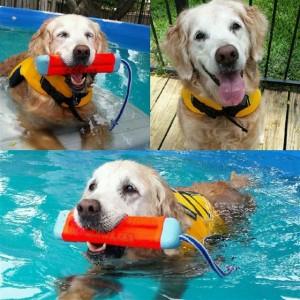
Denise Corliss installed a pool in her backyard to help her aging dog Bretagne maintain mobility by swimming daily.
Otto spent years tracking the health of dozens of 9/11 working dogs after the terrorist attacks. Among her favorite findings: Search and rescue dogs tend to live longer than other dogs.
“They have a bond with their handlers, they have purpose, they have physical fitness — it’s all really good for the dog and for the person who does this work,” Otto said. “Even on terrible assignments when they’re finding remains instead of survivors — can you imagine the closure they provided for families?
Otto’s work with the 9/11 dogs inspired her to launch the Penn Vet Working Dog Center at the University of Pennsylvania on Sept. 11, 2012. Through the center, dogs like Bretagne and Morgan — the last two surviving search dogs from 9/11 still participating in Otto’s health study — continue to be monitored, and puppies get trained to sniff out everything from explosives to narcotics to diseases to live humans buried in rubble. (Woodie did not participate in the health study.)
As a tribute, the puppies in training at the Working Dog Center all get named after 9/11 dogs. Bretagne’s namesake, dubbed “Bretagne 2,” recently moved in with a man who has Type 1 diabetes. She paws at his leg to alert him when his blood-sugar levels are out of normal range and he needs to eat.
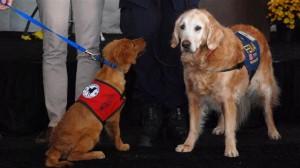
Bretagne got to meet her namesake, Bretagne 2, at the Penn Vet Working Dog Center on Sept. 11, 2012.
“That makes me so proud!” Corliss said. “I’m so humbled that they would find Bretagne worthy to have a puppy named after her who’s carrying on the tradition of the working dog.”
In the years that followed 9/11, Bretagne and Corliss deployed together to numerous disaster sites, including Hurricane Katrina, Hurricane Rita and Hurricane Ivan. Bretagne retired from formal search work at age 9 — but today, even though she’s roughly 93 in human years, she still loves to work. When school’s in session, she dons a service vest and prances purposefully through a local elementary school, where she helps first-graders and children with special needs learn how to read out loud.
“She still has this attitude of putting her paw up and saying, ‘Put me in, coach!’” Corliss said. “She absolutely loves it.”
And just as she did for that firefighter and other rescue workers at Ground Zero, she tends to sense which students and teachers are having rough days.
“I’ve seen Bretagne almost select a child,” said Shelley Swedlaw, a search dog handler and a former special education director who accompanies Bretagne to reading sessions. “She’s just really good about knowing who needs that kind, canine attention.”
At disaster sites, Bretagne’s presence always helped Corliss feel like she had “a secret advantage”: “I had my best friend sitting alongside me,” she said. This, in turn, helped Corliss learn important lessons from response work.
“Deployments put things back into perspective very quickly,” she said. “Every time I go on one, things that seemed to be really important before I left become less so.
“What do you think people are thinking about just before? It’s probably not work. They’re thinking about family. They’re thinking about love.”
~Via Today.com
Tags: 9/11 dog, dog hero, Hero Dog, Rescue Dog, search and rescue, search dog
